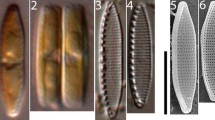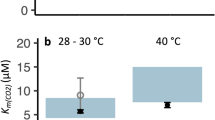Abstract.
Mechanisms of inorganic carbon assimilation were investigated in the deep-water alga Phyllariopsis purpurascens (C. Agardh) Henry et South (Laminariales, Phaeophyta). The gross photosynthetic rate as a function of external pH, at a constant concentration of 2 mM dissolved inorganic carbon (DIC), decreased sharply from pH 7.0 to 9.0, and was not substantially different from 0 above pH 9.0. These data indicate that P. purpurascens is inefficient in the use of external HCO3 − as a carbon source in photosynthesis. Moreover, the photosynthetic rate as a function of external DIC and the highest pH (9.01 ± 0.07) that this species can achieve in a closed system were consistent with a low capacity to use HCO3 −, in comparison to many other species of seaweeds. The role of external carbonic anhydrase (CA; EC 4.2.1.1) on carbon uptake was investigated by measuring both the HCO3 −-dependent O2 evolution and the CO2 uptake, at pH 5.5 and 8.0, and the rate of pH change in the external medium, in the presence of selected inhibitors of extra- and intracellular CA. Photosynthetic DIC-dependent O2 evolution was higher at pH 5.5 (where CO2 is the predominant form of DIC) than at pH 8.0 (where the predominant chemical species is HCO3 −). Both intra- and extracellular CA activity was detected. Dextran-bound sulfonamide (DBS; a specific inhibitor of extracellular CA) reduced the photosynthetic O2 evolution and CO2 uptake at pH 8.0, but there was no effect at pH 5.5. The pH-change rate of the medium, under saturating irradiance, was reduced by DBS. Phyllariopsis purpurascens has a low efficiency in the use of HCO3 − as carbon source in photosynthesis; nevertheless, the ion can be used after dehydration, in the external medium, catalyzed by extracellular CA. This mechanism could explain why the photosynthetic rate in situ was higher than that supported solely by the diffusion of CO2 from seawater.
Similar content being viewed by others
Author information
Authors and Affiliations
Additional information
Received: 6 March 1998 / Accepted: 22 June 1998
Rights and permissions
About this article
Cite this article
Flores-Moya, A., Fernández, J. The role of external carbonic anhydrase in the photosynthetic use of inorganic carbon in the deep-water alga Phyllariopsis purpurascens (Laminariales, Phaeophyta). Planta 207, 115–119 (1998). https://doi.org/10.1007/s004250050462
Issue Date:
DOI: https://doi.org/10.1007/s004250050462




